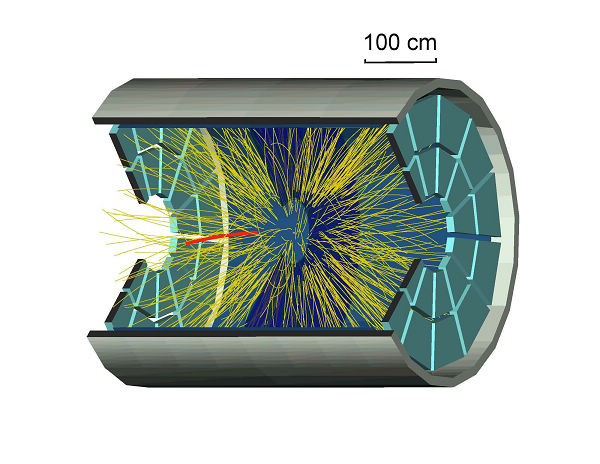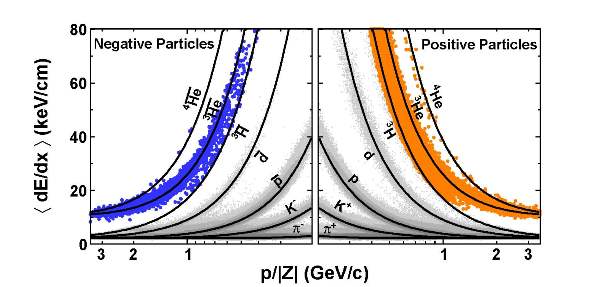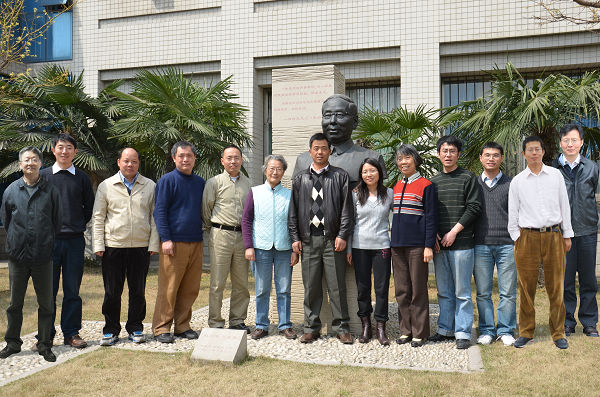






Shanghai, China
The international STAR collaboration which Chinese scientists participated in at the Relativistic Heavy Ion Collider (RHIC)— a particle accelerator used to simulate and study conditions of the early Universe at the U.S. Department of Energy’s Brookhaven National Laboratory(BNL) — has detected the antimatter partner of the helium nucleus: antihelium-4. This new particle, also known as the anti-alpha, is the heaviest antinucleus ever detected. The STAR physicists describe the new discovery in a paper in Nature, published online April 24, 2011.
At RHIC, head-on collisions of gold ions moving at nearly the speed of light simulate conditions just after the Big Bang. In these atomic smashups, quarks and antiquarks likewise emerge with approximately equal abundance. A major fraction of the stable antimatter produced in RHIC collisions leaves a clear signal in the STAR detector before annihilating with ordinary matter in outer part of the experimental apparatus.
By sifting through data for half a trillion charged particles emitted from almost one billion collisions, the STAR collaboration has detected 18 examples of the unique “signature” of the antihelium-4 nucleus based on the Time of Flight (TOF) detector which was designed and made by the STAR TOF project team from China and US (Figure 1). The new discovered anti-alpha nucleus consisting of two antiprotons and two antineutrons in a stable bound state that does not undergo radioactive decay, it has a negative electric charge that is twice that of an electron, while its mass is very close to four times that of a proton (Figure 2). Data plots show that the newly discovered anti-alphas are very cleanly separated from the lighter isotopes, and are located at their expected mass.

Figure 1: A three-dimensional rendering of the STAR TPC surrounded by the TOF barrel shown as the outermost cylinder. Tracks from an event which contains an anti- 4He are shown, with an anti-4He track highlighted in bold color.

Figure 2: <dE/dx> versus p/|Z|for negatively charged particles (left) and positively charged particles (right). The black curves show the expected values for each species. The lower edges of the colored bands correspond to the HLT’s online calculation of 3σ below the <dE/dx> band center for 3He.
The scientists also measured the antihelium-4 production rate in Gold-Gold nuclear interactions, and found that it is consistent with expectations based on a statistical coalescence of antiquarks from the soup of quarks and antiquarks generated in RHIC collisions. But the fact that 12 antiquarks combine to build such a complex antinucleus in a way that bears out these predictions is really quite remarkable considering it all takes place in the midst of rapidly expanding matter created at trillions of degrees and surviving for only ten trillionths of a trillionth of a second.
The ability to create and study antimatter in conditions similar to those of the early Universe isextreme important: One of the great mysteries of physics is why our Universe appears to be made entirely of ordinary matter when matter and antimatter are understood to have been created in equal amounts at the time of the Big Bang.
The new record of antimatter nuclei will likely stand for a long period, the scientists say, because the next heavier antimatter nucleus that does not undergo radioactive decay is predicted to be a million times more rare — and out of reach of today’s technology.
Knowing the production rate of these antinuclei is important to a wide range of scientific disciplines, including searches for new phenomena in the cosmos. For example, it ties in with the scientific goals of an experiment known as the Alpha Magnetic Spectrometer (AMS), which will be delivered to the International Space Station via one of the last space shuttle missions in April 2011. This experiment will search for antimatter in space. The new measurement from the STAR experiment would provide the quantitative background rate for comparison.
The STAR collaboration is composed of54 institutions from 12 countries, including Shanghai Institute of Applied Physics (SINAP), University of Science and Technology of China (USTC), Institute of Modern Physics (IMP), Tsinghua University, Central China Normal University (CCNU), Shandong University (Fig. 3). Research at RHIC is funded primarily by the U.S. Department of Energy (DOE)’s Office of Science and by various national and international collaborating institutions, with support from many funding agencies. Measurement capabilities vital to antihelium-4 identification were added to the STAR experiment in 2009 with the installation of a large TOF detector. This device was constructed jointly by Chinese institutions and U.S. and was funded jointly by the National Natural Science Foundation of China (NSFC), China’s Ministry of Science and Technology (MOST), Chinese Academy of Sciences (CAS) andU.S.-DOE’s Office of Science.
“Searching for an antimatter helium4 and other exotic particles is one of the scientific goals of TOF project. The performance of TOF detector has been very impressive, and the discovery of antimatter helium4marked an excellent beginning of the research program using TOF.” said the liaison of TOF project in USA, Huanzhong Huang, a Professor from the University of California, Los Angeles.
“The Chinese scientists have played important roles in this work. On the one hand, the measurement of antimatter Helium-4 is based on the TOF detector that designed and made by the Chinese TOF teams. On the other hand, the scientists are able to select collisions that may contain antimatter Helium-4 nuclei during online data-taking, because of the online High Level Trigger (HLT) developed by a group leaded by Dr. Aihong Tang, a lead author on the Nature paper and a physicistfrom BNL. And, Liang Xue and Hao Qiu, two PhD students from SINAP and IMP, respectively, have devoted themselves to HLT in the past three years and made important contributions to the discovery”, said Yu-Gang Ma, the convener of STAR collaboration in China, who is also a Professor in SINAP.
“The discovery of antimatter Helium-4 by the STAR collaboration is another milestone in high energy nuclear physics after the observation of antimatter hyper-triton by the same collaboration just last year. Chinese physicists have played important roles in both discoveries for the antimatter Helium-4 and hyper-triton, which shows that the international cooperation based on the research of fundamental science is very important. In the history of the search of antimatter, many Chinese scientists had devoted themselves to this work. For an example, Academician Zhongyao Zhao observed the sign of positron which was predicted by Dirac in 1930and a research group leaded by Academician Ganchang Wang discovered the antimatter Σ particle.” Said Academician Wenqing Shen, the deputy director of the NSFC.
The antihelium-4 discovery is being announced simultaneously in China and in the U.S.

Fig.3:Some members of the STAR collaboration stand in front of the bronze statue of Prof. Zhongyao Zhao at USTC.
From Left:Cheng Li(USTC),Ming Shao(USTC),Yi Wang(Tsinghua University),Feng Liu(CCNU),Nu Xu(LBNL/CCNU,STAR Spokesperson),Hongfang Chen(USTC),Yu-Gang Ma(SINAP, the convener of STAR collaboration in China),Lijuan Ruan(BNL,responsible person for the running of TOF),Xiaolian Wang(USTC),Yongjie Sun(USTC ),Zebo Tang(USTC),Zhangbu Xu(BNL),Huanzhong Huang(UCLA,US liaison of STAR-TOF project)